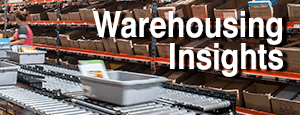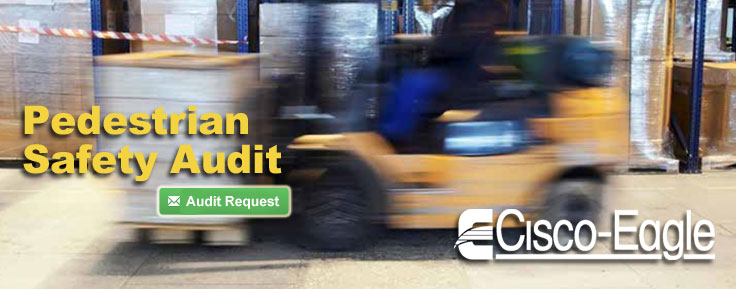Seeing Around Corners: The Danger Spots in Warehouses & Factories
How can you improve visibility and make these areas safer?

In an industrial environment, intersections can be dangerous. With fast-moving workers who are busy and probably distracted, and fast-moving forklifts that may have loads elevated that can obstruct the driver’s view, corners, ends of rack rows, and intersections can be the cause of many accidents. Whether it’s a worker walking and carrying a load, or a forklift on its way to the next pick, the chances of collisions, injuries, and damages are greater at intersections than most anywhere else. What are your options when it comes to making your intersections safer?
Training & process improvement
The first priority is training for both drivers and people who walk the floor. Drivers approaching any intersection should use horns and flashing lights to warn a pedestrian or another forklift that someone is on the other side. Pedestrians should understand the dangers and how to conduct themselves near industrial traffic. Flashing lights are more important in areas where the ambient noise level is high, or where the light levels are poor.
Keep activities separated from corners and intersections as much as possible. Don’t store picking bins or carton pick areas near a corner where industrial traffic frequently travels. Keep those activities in the centers of aisles, or separated from pallet rack aisles if possible. The same goes for workstations. Don’t place those near corners and intersection. Facility design should actively discourage lingering or foot traffic near these danger points.
If possible, lightly load that last bay at the end of an aisle so that people on both sides can see through to both the parallel and perpendicular aisles. Forklifts shouldn’t drive with an elevated load that can obstruct the drivers’ view of the intersection as he enters it. Don’t allow tall, loaded pallets or other visual obstructions to be placed at the end of a rack aisle so it can further obscure visibility.
Bright safety vests or other attire are always recommended where industrial traffic and people mix. A traffic management plan is also essential to ensure people and forklifts don’t mingle.
Visibility mirrors
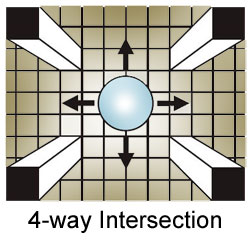
Properly placed safety mirrors are an inexpensive way to increase visibility at intersections. They can be used in conjunction with other safety methods and training to help keep people aware of the corner – and what might be coming the other direction.
Mirror specification (in general):
- Use convex mirrors to provide a view for a specific angle in a 160-degree range.
- Use dome mirrors to provide views to each direction in a 4-way situation.
For both domes and convex mirrors, specify 1″ of mirror for every foot of viewing distance. So, a 36” mirror would, by that rule of thumb, provide 36 feet of viewing distance. This should be tested once you have installed a mirror so that you can mark the range of the mirrors on the floor and integrate this into your safety training program. Knowing how far the mirror allows visibility will be helpful to everyone who uses the aisles.
More advanced mirrors?
There are also advanced motion sensor mirrors that flash warning lights or text when traffic is detected. These systems let people afoot and forklift drivers see the mirror, but also provide a higher level of warning and detection. These sophisticated sensor mirrors can be ideal for the right types of intersections.
Sensors and automation
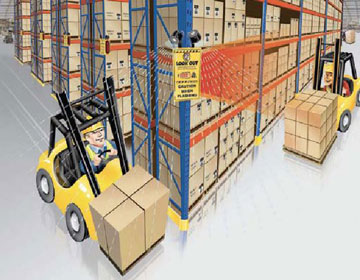
Many operations have decided that the relatively low cost of new-generation motion detection systems have helped make them essential for intersections and corners.
There are several types of warehouse sensors, including ones specifically designed to monitor rack rows and intersections. They’re all inexpensive to install, and will monitor a specific area. They can work with mirrors to provide a system that triggers at the presence of motion within their defined zone, but also lets people see into aisles as they approach. LED lights flash to warn inbound forklifts when the sensor is triggered. You can typically add audible alarms to these systems.
For other intersection types, you can utilize motion detection technologies that project warnings onto the floor (they are surprisingly visible), or even act as a traffic light/stop light system in the warehouse.
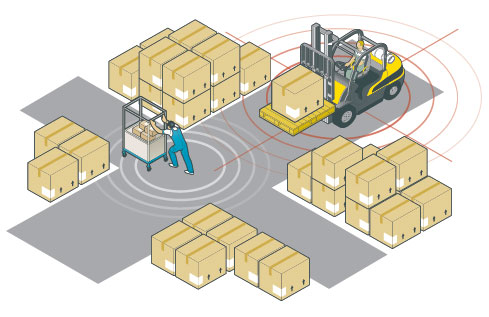
There are also systems that don’t have to be installed in your facility to guard a particular area, such as ZoneSafe forklift proximity warning modules. This concept places a warning system on the forklift, with a control module and tags carried by pedestrians. This system doesn’t guard corners and intersections in particular; it will guard people at any point in the facility including corners, providing both audible and visual warnings to the drivers if a pedestrian is in a preconfigured radius. This flexibility makes it an ideal system for many facilities where fixed sensors aren’t an option.
Of course, like all safety measures, these sensors and mirrors can’t ensure that a collision doesn’t occur. If you install them, make sure employees are trained to observe and understand their signals. In particular, pedestrians shouldn’t take right-of-way for granted before they enter an intersection.
The use of this or any warning device does not insure that all drivers or pedestrians will observe or react to a warning signal. Never take the right-of-way for granted. Train your people to proceed safely before entering an intersection, driving in traffic, backing in or out of a tight location, driving in or around traffic lanes or near pedestrian walkways.
Guard Rails and Solid Barriers
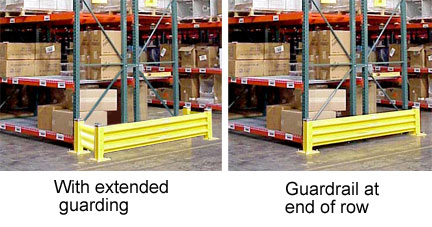
You often see steel or flexible poly guard rails installed at the end of rack rows, typically to protect the rack from forklift impact damage. This is usually done in a single straight, post-to-post run. But you can also use this simple protective technique to make these aisles safer. By swapping out the straight rail for a “horse shoe” you extend the row so that forklifts and pedestrians are forced “out” from the aisle a foot or two into a wider arc as they emerge from it.
This makes it easier to see from both sides of the rack aisle, since you are turning once you get past the short guard rail and not the potentially tall, visually obscured rack, and slows traffic in both directions. That space isn’t typically missed and the cost is not significant.
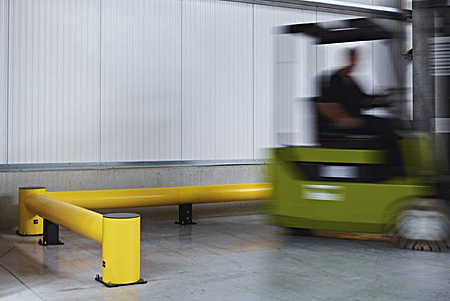
You can also use guard rails to separate longer aisles of traffic. This method is necessary at times, when people and forklift share the same walkway on a frequent basis. Some companies tend to use simple paint lines for this, to help increase flexibility (people can cross that line when necessary). The issue here is that the same flexibility to cross lines is what helps endanger them. One compromise is to utilize lower profile rails, which people would have to step over, and forklifts could not drive over. This is a compromise position between tall, restrictive hand rails or guard rails and the permissive aspects of simple painted lines. In general, though, hard separation and crossing control is best for safety. Install lift-out guardrail systems if trucks need to access something behind the line on a regular basis.
Another idea is to install speed bumps, which will deter drivers from crossing the lines. They don’t restrict people on foot, but are better than a painted line.
Gates and automated barriers
AisleCop® forklift safety systems: These systems are typically used to cross a defined area, like a crosswalk. However, for dangerous corners, it is possible to install sensors and gates that can more directly control traffic and how it merges. This might typically be done with a boom arm system that closes an aisle off when traffic is detected on the other side, reducing the chances of an accident when both entities (forklifts or pedestrians) meet at a corner.
These systems are probably the most reliable protective measure, when combined with training and processes. They manage either the pedestrians, forklifts, or both and are completely configurable to help reduce the chances of accidents.
Tags: OSHA, industrial safety, warehouse safety, forklifts, AisleCop, sensors, ZoneSafe
Scott Stone is Cisco-Eagle's Vice President of Marketing with 35 years of experience in material handling, warehousing and industrial operations. His work is published in multiple industry journals an websites on a variety of warehousing topics. He writes about automation, warehousing, safety, manufacturing and other areas of concern for industrial operations and those who operate them.



